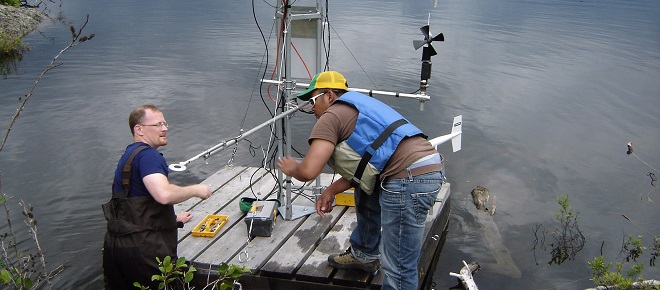Why the math on de-funding Experimental Lakes makes no sense
As in healthcare, prevention is a cost-saving measure
Scientists set-up a raft with one of a series of micro-meterological stations on a lake, in this undated photo. Scientific projects could die on the vine because of cuts to the federal Fisheries Department, university researchers say. THE CANADIAN PRESS/ho, Experimental Lakes Area
Share

Here’s an interesting story:
In the mid 1970s a group of scientists decided to see what happens to a lake when water acidity levels rise. The researchers were fortunate enough to live in a country with one of the world’s highest rates of renewable freshwater per capita. There was enough water, and enough of it far away from human developments, that they they could treat entire lakes as their real-life laboratory.
They picked one such lake and, from 1976 to the early 1980s, poured measured amounts of sulfuric acid into it. The transformation was stunning: “Several key species, including Mysis shrimp, crayfish, and fathead minnows, disappeared entirely from the lake. The lake trout and white sucker populations began to experience reproductive failure.” By 1981 most adult trouts in the lake were so undernourished they looked more like sardines.
In 1984, the scientists began scaling back their dumping activity to allow the acidity levels in the lake to return to their original level. Again, they watched and took notes: “Almost immediately, the lake ecosystem began to respond… The white suckers successfully reproduced and the adult trout were able to feed on the young suckers. The condition of the trout improved markedly… Soon, the trout as well were successfully reproducing.”
The experiment, as many of you surely figured out, took place at the Experimental Lakes research area, in northwestern Ontario. In 2012 the Harper government decided to de-fund this 58-lake facility as part of a series of budget cuts to Department of Fisheries and Oceans. Funding, which Premier Kathleen Wynne announced today will now come from Ontario, amounted to $2 million per year.
Now, here’s another interesting story:
Concerned about water shortages due to persistent dry weather, in 2007 Australians decided to build a desalination plant in Sydney. The $1.9 billion project took years to complete, but while workers were labouring away at it, drought conditions eased. By the time it was finished, there was no need for the facility. The government announced last year it would mothball it — but Australian taxpayers are still paying $15 million a month to cover construction costs.
This latter story is referenced new OECD study on water management. The first building block in devising sound water policies, the report argues, is knowledge: Having a pretty good idea of how human activity affects your water resources is essential to being able to devising the most cost-efficient management policies. Sydney, of course, is an example of what happens when the government doesn’t have a clue. “In Sydney, Australia, for example,” notes the OECD, “analysis shows that if scarcity pricing had been introduced at an appropriate time it could have reduced water demand to a level which no longer required the development of a costly new desalination plant.”
And that’s why axing funding for the Experimental Lakes as a budget-slashing measure makes as much as eliminating preventive care in order to reduce public health costs.